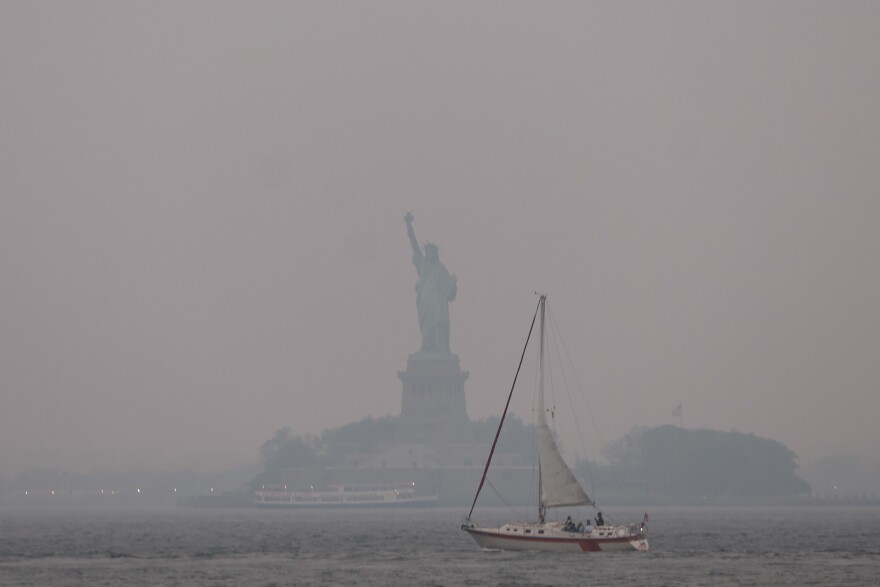Truth matters. Community matters. Your support makes both possible. LAist is one of the few places where news remains independent and free from political and corporate influence. Stand up for truth and for LAist. Make your year-end tax-deductible gift now.
How to keep yourself safe from wildfire smoke

Update
Californians are sadly very familiar with the effects of wildfire smoke — even if the fire is very far away. So we wanted to share some tips with our East Coast friends who are facing shocking air quality due to massive fires in Canada. Here's what you need to know:
Even if you don't live or work near a major fire, you can still be affected by smoke particles in the air. So, what's in that smoke, and how much should you worry about it?
Depending on the fire, the smoke can be made up of various substances, including carbon dioxide, carbon monoxide, water vapor, particulate matter, organic chemicals, nitrogen oxides, and more. Exposure to smoke can cause a range of health effects, from eye and lung irritation to asthma and premature death.
Those especially sensitive to smoke include:
- People with asthma
- People with cardiovascular diseases
- People with respiratory diseases
- The elderly
- Young children
- Pregnant women
Particulate matter is the main public health threat during short-term exposure to wildfire smoke, so it's crucial to protect yourself.
"Really it's about common sense," said Philip Fine of the South Coast Air Quality Management District. "If you can see the smoke, if you can smell the smoke, you can tell when the particulate matter levels are really high. If you can do that, you should exercise caution."
Here are some tips on how to stay safe if there's wildfire smoke in your area:

Stay Indoors
Thinking of going outside? Don't. It's best to stay inside with the air conditioner on. And you're going to want filtered air. Many evaporative cooling systems, aka "swamp coolers," don't filter the air.
Once you turn on the cool, filtered air, keep the doors and windows closed to keep the unhealthy air outside. You're also going to want to avoid vigorous activity — anything that makes you breathe deeply.
Do not use any indoor or outdoor wood-burning appliances or fireplaces. And when smoke subsides, you should air out your home to clear any polluted air that might be trapped inside.
But what if you're stuck in a car or driving through areas of smoke? Same deal. Close the windows and doors and run your car's air conditioner. AQMD says that carbon dioxide levels can spike quickly in newer cars if vents and windows are closed and the circulation setting is on, so crack the windows once you're in there for a while to prevent grogginess.
Use Protective Masks
The best thing to do is to seek shelter — but if you must be outside, being prepared is key. Wear an N95 or P100 respirator mask. These are the kind you see people use when they work with lots of debris in the air. They keep most of the smoke particles from damaging your lungs. We tested some other masks, and they didn't hold up as well.
Experts recommend that anyone in a fire-prone area keep such a mask in an emergency kit.
One silver lining of the pandemic is that most of us now either already have a supply of high quality masks or know how to get one. If you don't already have one, in emergencies they may be available at evacuation centers.
Check The Air
Smoke isn't the only thing that can make air quality bad.
Wherever you are in the U.S. you can check local air quality at AirNow, which uses data from the Environmental Protection Agency, National Oceanic and Atmospheric Administration (NOAA), National Park Service, NASA, Centers for Disease Control, and tribal, state, and local air quality agencies.
If you're in Southern California, check with the South Coast Air Quality Management District which tracks smoke alerts and also ozone and other pollutants that make the air unhealthy to breathe. You can sign up for alerts from their website or check the air quality forecast on their interactive map.
More fire resources
LAist: Tips and Explainers
- Listen to The Big Burn, our podcast that will get you motivated to get ready
- Wildfires are getting worse. What you need to know
- Understanding climate change may help you feel less helpless
- Every day is now fire season. Let's get you ready for the next wildfire burning near you
- Evacuation terms can be confusing. Here’s what they mean and how to sign up for alerts
- How to keep yourself safe from wildfire smoke
- The air is brown — should I wear a mask? We tested 5 out and have some advice
- This is why fire officials don't want you to stay and defend your home
- What does 'containment' of a fire mean, exactly
- How to avoid getting towed during LA's red flag parking restrictions
- What to do — and not do — when you get home after a wildfire
- If you want to help fire victims, resist the urge to volunteer
Megan Larson contributed to this story.
Updated September 9, 2022 at 11:52 AM PDT
This story was updated with more recent information about masks and updated links to external sources. It was original published in 2018.







